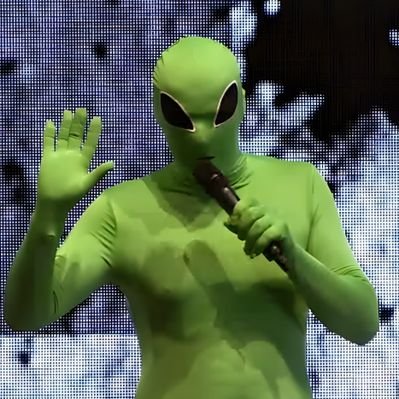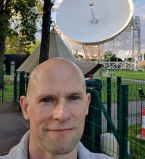
Research: my research focuses on exoplanets - planets that orbit stars other than the Sun. I also undertake research into smart detection strategies for extra-terrestrial intelligence. Click on the topics below for project summaries.
Mapping the cool, low-mass exoplanet regime is crucial for testing planet formation theory. Unlike larger or warmer planets, cool low-mass planets are thought to remain orbiting largely at the position of their formation.
NASA's upcoming $4.3 billion Nancy Grace Roman Space Telescope (Roman, previously named WFIRST), which is scheduled for launch in late 2026, will spend around 25% of its observing time conducting the Galactic Bulge Time Domain Survey (GBTDS). The key science driver for the GBTDS will be a Roman Galactic Exoplanet Survey (RGES) of around 1,400 cool exoplanets across the Galaxy down to the mass of Mars using the microlensing method. With the RGES we also expect to discover 60,000-200,000 transiting exoplanets over Galactic distances. This combined dataset of hot and cool planets, detected through transit and microlensing methods, will revolutionize our knowledge of the demographics of exoplanets throughout the Galaxy. We will find out how common are planetary architectures like our own solar system and we will gain a much better insight into the Galactic abundance of habitable zone planets. I am the sole ESA-Appointed Scientist to the RGES Project Infrastructure Team that is working to design the survey and develop the analysis tools for the microlensing science. I also lead the Survey Optimization and Exoplanet Demographics Working Group for the Transits in the Roman Exoplanet Survey (TRExS), a NASA-selected Roman WFI Science Survey that will search the GBTDS dataset for transiting planets.
I also lead the Exoplanet Science Working Group for the recently launched ESA Euclid mission. Exoplanets is an additional science acitivity for Euclid alongside its primary cosmology science. Euclid has the potential to coordinate observations with Roman to enable much higher precision in exoplanet mass measurements. Working together, Roman and Euclid can also achieve science that is difficult or impossible for either to achieve alone. This includes confirming and accurately characterizing the suspected large population of free-floating planets, as well as detecting and characterizing the first exomoons (moons around exoplanets).
I am Principal Investigator for an STFC-funded study of free-floating planets using data obtained from Campaign 9 of the extended K2 mission of NASA's Kepler space telescoope. We used the technique of gravitational microlensing to find evidence for planets. This is the first time that a space telescope has been used to conduct an exoplanet microlensing survey.
In work led by my postdoc, Dr Iain McDonald, we built a detection pipeline that found 27 candidate short-timescale microlensing events consistent with planetary masses. Five of these were previously unreported. Four out of these five new events are consistent with microlensing due to free-floating planets of around Earth mass (link to paper).
Recently, work by a large international team led by my PhD student, David Specht, has confirmed that the fifth event is a bound exoplanet. K2-2016-BLG-0005Lb is a close analogue of Jupiter and is the first confirmed exoplanet discovered from space using gravitational lensing (link to paper). K2-2016-BLG-0005Lb is around twice as distance from Earth as any of the 2,700 previous confirmed exoplanets discovered by Kepler using the transit method, highlighting the ability of space-based microlensing for characterizing the exoplanet population across Galactic distance scales.
I am Principal Investigator for the Spectroscopy and Photometry of Exoplanet Atmospheres Research Network (SPEARNET) that is pioneering an automated approach to detecting and characterising the atmospheres of exoplanets. SPEARNET has developed world-leading tools for fitting multi-wavelength exoplanet transit signals and innovative machine learning approaches for rapid fitting of planet atmosphere models to data collected from a heterogenous, globally-distributed network of optical and infrared telescopes.
Our most recent results include a new measurement of the water vapour content of exoplanet HAT-P-26b, and the first transmission spectrum of an exoplanet from simultaneous, fully-integrated fitting of transit data from both Hubble and James Webb Space Telescope observations.
I have pioneered a new approach to calculating the rate of microlensing in our Galaxy based on highly detailed synthetic Galactic models. This has led to the development of the Manchester-Besançon Microlensing Simulator (MaBμlS). MaBμlS is being used by both the ESA Euclid and NASA Nancy Grace Roman Space Telescope teams to help design exoplanet microlensing surveys.
MaBμlS is designed for multiwavelegth microlensing studies and is the most thoroughly calibrated microlensing model to date. It provides a very good match to the 8,000-event OGLE optical microlensing catalogue, as well as a 1,600-event near-infrared catalogue extracted from the VVV survey.
I proposed Mutual Detectability as a game-theory based approach to the targetted search for extra-terrestrial intelligence (SETI). Mutual Detectability involves targetting systems that have an opportunity to view our planet the same way we can view theirs (e.g. via the transit method). This may lead to a mutually shared incentive to make contact as both parties realise the other party may know about their potential existence. This targetted SETI strategy is a direct analogue of a famous problem where two strangers who've never met and cannot communicate with each other have to decide on the best way to find each other in New York city on a particular day. It's an example of a coordination game between two cooperating but non-communicating participants, described by Nobel prize-winning economist and Cold War strategist Thomas Schelling in his book The Strategy of Conflict. I show that this approach, when applied to transiting systems, leads to the idea that a good target strategy is to focus on searching for transmissions from potentially habitable transiting planets orbiting low-mass stars that are located close to the Ecliptic plane. With other colleagues, I have proposed such a survey for the upcoming NASA Roman mission.
Please get in touch with me if you are interested in working in these areas for a PhD or MSc.
 Teaching: I currently teach a 2nd-year undergraduate course on
galaxies, having
previously written and taught a 3rd/4th-year
course on exoplanets.
I also demonstrate
astrophysics experiments in the 3rd-year physics lab, including one on
microlensing and difference imaging that I created a few years back.
Teaching: I currently teach a 2nd-year undergraduate course on
galaxies, having
previously written and taught a 3rd/4th-year
course on exoplanets.
I also demonstrate
astrophysics experiments in the 3rd-year physics lab, including one on
microlensing and difference imaging that I created a few years back.
 Public talks and stand-up comedy: Science is a serious business, but
I don't take myself too seriously. I have been known occassionally to climb
into a green alien morphsuit to become the Jodrell Bank Alien. Jodrell
Bank Alien is science outreach aimed at audiences who enjoy a laugh with
their science. My alien alter-ego has given science talks at major festivals and
has peformed science stand-up
comedy to adult audiences. Jodrell Bank Alien delivers a close
encounter that is hard to forget ... no matter how hard you try.
Public talks and stand-up comedy: Science is a serious business, but
I don't take myself too seriously. I have been known occassionally to climb
into a green alien morphsuit to become the Jodrell Bank Alien. Jodrell
Bank Alien is science outreach aimed at audiences who enjoy a laugh with
their science. My alien alter-ego has given science talks at major festivals and
has peformed science stand-up
comedy to adult audiences. Jodrell Bank Alien delivers a close
encounter that is hard to forget ... no matter how hard you try.
Feel free to get in touch via email if you would like me to give a talk at your event.

 ORCiD
ORCiD